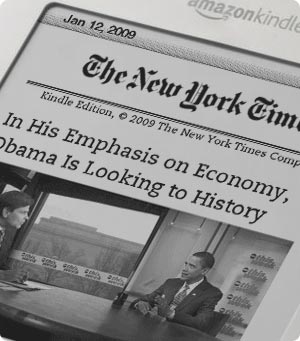Exuberance over the new Amazon Kindle as a potential salve for the news industry’s pain is beginning to fade as analysts dissect the financial realities. Amazon created a stir last week by introducing a large-screen version of the electronic book that does a decent job of rendering the familiar look and feel of a printed newspaper. It also announced that The New York Times, the Washington Post and others have signed up to deliver their content for a real live subscription fee. Hallelujah! Readers paying for the news!
Buried in the excitement were the terms that Amazon is demanding its news partners accept in order to join the parade: Amazon gets to keep 70% of the subscription fees. This is a huge strategic mistake that Amazon should address toute de suite.
Critics are already taking apart the strategy. Writing on Columbia Journalism Review, Ryan Chittum runs the numbers. “So of the $14 a month a reader pays for a The New York Times, say, the Times itself actually gets about $4.20. The rest goes to Amazon and to the wireless carrier that transmits the data.” He figures that if every one of the Times‘ subscribers signed up for a Kindle stream at $14/month, the revenue would barely cover the cost of the paper’s newsroom operations. And that’s assuming the Times kept all the money; in reality, it keeps only 30%
Amazon has a historic opportunity. Lacking serious competition, Kindle could own the market for electronic newspaper delivery over the next couple of years. Amazon should be making it a no-brainer for every news organization in the world to deliver content over its device. Instead of taking 70% of the subscription fees, it should be giving 90% of those fees to the publishers in a land-grab bid for market share. Alas, it’s trying to make a few quick bucks up front on a group that can’t afford to pay, and it’s mortgaging its long-term franchise in the process. It’s very un-Amazon-like to think so tactically. There’s still time to undo the damage and let’s hope it does so.
Writer Stephen Silver says the Kindle suffers from a more basic problem: it’s newspaper interface sucks “It’s slow, hard to navigate and in no way preferable to the newspaper interfaces on any smart phone, much less the Web,” he writes on North Star Writers Group. “Hell, the Times application on the BlackBerry my dad had five years ago was better-looking and easier to use than the Kindle’s version is now.”
Manifesto for Reinvention
As he does so often, Mark Potts hits the nail on the head with an essay on the lack of a magic bullet for suffering publishers. Kicking off with a short swipe at the Kindle-as-messiah craze, Potts digs in to the real problems publishers have to address: they’re too broad, too inwardly focused, and too addicted to traditional advertising models.
Potts runs down a list of changes publishers need to make in order to survive in an atomized information world. There’s nothing on his list that hasn’t been suggested before, but the summary brings a common-sense rationality to the debate. This is like a checklist for survival.
We are swimming in information, he notes. So why not aggregate what’s already out there instead of spending money on reporters to generate more information? Sounds good to us. The market for local advertising is estimated to be $25 billion annually. No one has figured out how to unlock it. Metro daily newspapers are in the best position to do that. So why are they still chasing national display advertising accounts? This piece is like a short manifesto for reinvention that publishers should frame and hang on their walls.
Miscellany
The publisher of the Utica Observer-Dispatch was probably just trying to be folksy in devoting her column to the most common complaints readers have about their newspapers, but she inadvertently ends up make an argument for why print is dying so quickly. Five days to get a letter to the editor published is actually pretty good, says Donna Donovan. “If there’s a lag in your letter getting in, it might be because we couldn’t reach you to verify it, or we have a backlog.” Five days??
Now that it has a monopoly in Denver, MediaNews Group is going to start charging readers for some content. Readers won’t pay by the article, but will get a vague set of bundled services that includes fees for content. Exactly what those services will be hasn’t been specified. The whole plan sounds pretty vague at this point.
Someone has bid $13,000 for a non-paying internship at Huffington Post, the website often cited as a next-generation news publication. And the bidding doesn’t end for another two weeks. Proceeds go to charity. Believe us, it’s a lot cheaper to start a blog.
 The newest port in a storm for the embattled newspaper industry is
The newest port in a storm for the embattled newspaper industry is 
 Does Lindsay Lohan
Does Lindsay Lohan  ached that would achieve the $10 million in cuts the Globe had asked the Newspaper Guild to make. The union represents about 700 Globe employees, including newsroom staff. The proposed agreement will be submitted to Guild membership for approval on Thursday. Until then, the terms are secret.
ached that would achieve the $10 million in cuts the Globe had asked the Newspaper Guild to make. The union represents about 700 Globe employees, including newsroom staff. The proposed agreement will be submitted to Guild membership for approval on Thursday. Until then, the terms are secret. You could do a lot worse than spend the next 20 minutes reading Jason Pontin’s
You could do a lot worse than spend the next 20 minutes reading Jason Pontin’s  Billionaire investor Warren Buffett reads five newspapers every day, but he
Billionaire investor Warren Buffett reads five newspapers every day, but he 

